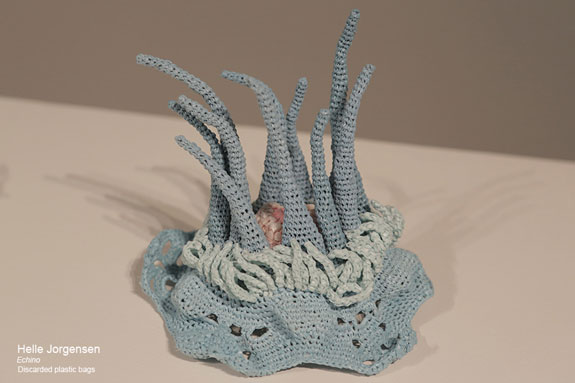Trash as Treasure: Crocheting Plastic Coral Reefs
With yarn made from discarded plastic bags, Australian artist Helle Jorgensen stitches delicate sculptures of corals
![]()
Helle Jorgensen walks the beaches near her home in Sydney, collecting trash that the tide brings ashore. Her bycatch is varied: ropes, cigarette lighters, even toothbrushes. And, plastic bags—the real catch she is after—are bountiful.
According to the artist, white, gray, blue and green bags are abundant in Australian waters. She also supplements her supply with imports. “I get lots of bags from all over the world,” says Jorgensen, in an audio slideshow produced by the American Association for the Advancement of Science (AAAS). When she is traveling in the United Kingdom, for instance, Jorgensen snags fantastic orange bags from the supermarket chain Sainsbury’s and can count on the retail giant Marks and Spencer doling out beautiful chartreuse bags. “I have a bit of an eye for collecting really colorful bags,” she says. In the meantime, she also has friends sending her red, purple and pink ones from around the world.
Jorgensen puts the bags, that might otherwise end up tangled in a tree or floating in the ocean, to good use. She flattens each bag and folds it lengthwise several times to from a strip about an inch wide. Using scissors, she lops off the bag’s handles and bottom seam and repeatedly cuts across the strip’s width to form small bands. These bands are actually loops, when unfolded. (If it helps, the process is shown here, in pictures.) The artist then knots these loops together to construct a skein of double-stranded plastic yarn.
“It’s very time consuming, but strangely cathartic,” writes Jorgensen, on her personal Web site.
This homespun plastic yarn is Jorgensen’s artistic medium. Improvising as she goes, Jorgensen crochets fabulous sculptures of colorful brain, tube and pillar corals. Her tightly stitched coral colonies, some of which are currently on exhibition at the AAAS Art Gallery in Washington, D.C., incorporate many of the shapes—wrinkles, pipes and tentacles—seen in living coral reefs.
Jorgensen, who lived in Denmark until her teenage years, learned how to crochet as a child; her paternal grandmother, Agnes Jorgensen, taught her. Having picked up different tricks and techniques along the way, she is now able to stray from patterns and essentially free-form crochet sculptures to her liking. In her art making, Jorgensen draws on her professional experience in the sciences. With a degree in biology, she was a research geneticist for some time, before training to be a horticulturist. She stills spends a few days a week operating a small horticulture business. “All my skills and interests have merged to create these and I finally feel as if I have found my niche,” Jorgensen has said, about her crocheted corals.
Margaret and Christine Wertheim, fellow Australians and (surprisingly) fellow crocheters of coral, recruited Jorgensen to help with the Hyperbolic Crochet Coral Reef, a massive participatory science and art project that kicked off in 2005. Communities around the world joined forces to crochet (using a special mathematics-inspired technique called “hyperbolic crochet“) an expansive reef, which then traveled with much fanfare to numerous art and science museums, including the Smithsonian’s National Museum of Natural History.
“Disposable Culture,” an exhibition at the AAAS Art Gallery through November 30, features a selection of Jorgensen’s coral sculptures, as well as works by other artists who depict and incorporate cast-off materials in their art.
On a recent visit to the gallery, I admired Jorgensen’s delicate corals. With such tiny stitches, the sculptures are so refined. I was particularly awed by a piece called “The Retail Reef,” which weaves together bright oranges, greens and yellows with some sprouting purples and creeping reds. As evidenced by the sculpture’s name, Jorgensen’s mind is never far from her source material–plastic bags and other trash that continues to collect in places like the Great Pacific Garbage Patch, a rubbish pile nearly twice the size of Texas floating in the North Pacific Ocean.
“I guess I would really like to get the message across that I am concerned about the amount of pollution in the ocean, plastic pollution in particular,” says Jorgensen, in the audio slideshow. “These pieces are a reflection of creating something evocative, hopefully, and beautiful to look at, from discarded plastic.”
“Disposable Culture” is on display at the AAAS Art Gallery through November 30, 2012. The gallery is open to the public Monday through Friday, from 9 a.m. to 5 p.m.
/https://tf-cmsv2-smithsonianmag-media.s3.amazonaws.com/accounts/headshot/megan.png)




/https://tf-cmsv2-smithsonianmag-media.s3.amazonaws.com/accounts/headshot/megan.png)